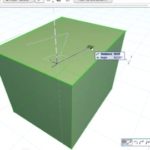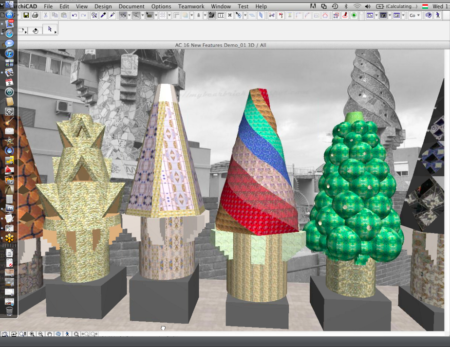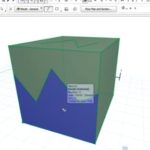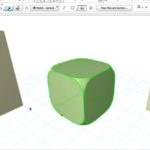Continued from page 1
“The real power of the Morph Tool is in its flexibilty,” says Tibor Szolnoki. “This stunning new library building in Norway was a lot of fun recreating from scratch using this technology.” (see image 01 box shot above)

03 - Drawing lines, polys, across surfaces separates the surfaces allowing push or pull or other modification of those morph surfaces.
The Morph Tool will bring to ArchiCAD users popular modeling techniques such as Push/Pull with numerical accuracy via the Tracker user interface element. Users can quickly work with basic solids or define basic planes (surfaces) by defining their “edges” in space in much the same manner as Google’s SketchUp. A powerful capability with the new Morph Tool is its ability to go back and forth between solid and surfaces. Another strength is its ability to model curve bodies by utilizing complex splines as edges as well as the manipulation of morph edges. (see images 03-05)
In fact, Graphisoft says that the new Morph Tool has no geometric limitation and there is no longer any need to import special shapes from other 3D programs. Yet the Morph Tool creates “morph” elements which exist as full-fledged ArchiCAD components and appear in all views and lists just like other elements (eg: walls, slabs, etc). Once more, existing ArchiCAD elements (eg: roofs) can be transformed into morph elements and then further edit into any form imaginable. Morph elements can be classified as any building element type for exchanging data with the engineers or can be saved as GDL objects for sharing with the BIM components community.
To demonstrate just how powerful and flexible the new Morph Tool is the company’s first set of videos on this new tool quickly and convincingly model complex chimney’s by famed architect Antoni Gaudi. The set of videos also demonstrate the new Morph Tool’s flexible texture mapping. (see image 06 and here for videos)

06 - The Chimneys of Antoni Gaudi. These are all modeled with ArchiCAD 16's new Morph Tool and demonstrated on YouTube. (image courtesy Graphisoft).
Graphisoft’s Morph Tool packages the power of both solids and surfaces modeling functionality into a single tool with various sub-setting options. At the base of it, the new Morph Tool can function much like Google’s SketchUp (recently acquired by Trimble) creating surface-based models or 3D planar objects with editable edges. You can quickly define a polygon on any plane in 3D and create a “morph surface.” Morph surfaces are themselves defined or bounded by “morph edges.” And these morph edges are constituted by “morph nodes.”
As you can see by watching the many short videos on the new Morph Tool, there are many ways to create a morph element, including revolves. Morph element corners can be filleted or chamfered and the user has the ability to set the resolution of the curvature of the fillet. You can also curve any morph edge and several different ways. Editing morphs at the node level provides even greater form-making freedom. And you can edit morph elements in numerous ways and split them, combine (add) them or subtract from them. These boolean operations provide flexibility in the form making process. Morphs can even have bulged faces and you can put bulges on top of bulged faces.
next page: BIM Components






Reader Comments
Comments for this story are closed